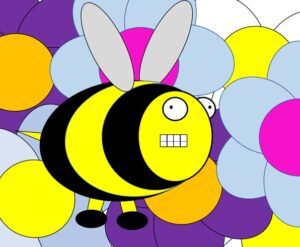I was watching the National Geographic channel the other night and there was a short film, from a series entitled Innovation Explorers, about a scientist working in robotics. He starts with what he admits is a grand statement; that “robotics will be the next internet”, before explaining the project they’re working on; building a drone of bee-like robots, inspired by nature. He explains that while individual bees cannot fly far, by working together, they are very successful before adding that his robbers “could be useful in applications where you don’t want to put a human or animal”.

Taken at face value, this appears to be a great example of “innovation for the sake of innovation”. It’s not clear how this innovation could be put to practical use; what currently unsolvable problem will suddenly be unlocked by the appearance of a robobee (or, indeed, a hive of robobees) on the scene. They’re going to have to wait and see if someone else can find the problem that only a robobee can solve.
This set my mind off in 2 directions. The first is the parallel with what I see happening in many organisations. Innovation is important (it must be because everyone says so). Innovation is “the next big thing” and “if you don’t innovate, you die”. Now, there’s obviously truth in that; think of all the former global giants who’ve been on the wrong side of a disruption and are now desperately playing “catch-up” or have retired from the race altogether. But many organisations don’t stop to think about the basic questions: what, where and why do they need to innovate? They start with a generic “how?” and, in many cases I’ve seen, the result looks something like a mid-90s “Employee Suggestion Scheme”. The focus is on ideation, and generally it’s quantity over quality.
Without a clear focus, ideas may come thick and fast but very few are addressing the “big issues”. And, more often than not, the system becomes overloaded as the process for sorting the “gold from the dirt” cannot cope. The organisations that “get it” focus the creative energy and talent of the people, and other stakeholders, on the strategic challenges they face. They start with a set of specific problems that need to be solved. They don’t start with a solution, then go looking for the problem it solves.
Which takes me back to the other direction my somewhat scrambled brain wandered off in; what do bees actually do? For years, scientists have tried to work out how such a tiny, fragile and, let’s face it, not very agile creature manages to survive. How can they fly such long distances with those wings? How do they communicate the location of food sources so effectively? How do they even remember where those food sources are with such a tiny brain? The sharp-eyed amongst you will have noticed these are the “how”, not “what” questions. With all the coverage of COP24, it’s clear the scientists are now understanding the “what” better than the “how” as, with global bee populations declining, we’re finding out the hard way what they do. It may be too late to find out how.
Which leads me back to our intrepid inventor and his robobees. Maybe this is his niche – the problem that fits his solution. Maybe his robobees can help the eco-system survive by doing what real bees do, while someone else works out how we can help the bees recover their numbers sufficiently. But, if we’re going to be able to successfully create a robobee capable of doing this job, we would have to have a better understanding not only of what they do, but how they do it.
However, as a species, maybe we have taken a step forward. At least we have now identified a problem that needs an innovative solution. Get your thinking caps on.
















There are two types of innovation: starts from a problem and looking for a solution; and starts from a technique and looking for the best application.
When nylon was initially invented, no one knows that it cold be used for lady silk stockings, and parachute cord.
The question is, most organizations have not enough resource to do the second innovation by their own effort, so organizations should monitor any newly evolved technique, evaluate how it and its trend will impact organization’s industry and take action.
I agree, Shaojian – the “get your thinking caps on” ending applies to finding a practical use for robobees as much as to finding a solution to the problem we face of the decline in real bees. My concern is I’ve seen a significant number of organisations implementing “innovation” as the next “flavour of the month”. Without a clear direction and focus, they’re not only doomed to fail but also risk disengaging employees (as they’ve been asked to “contribute ideas” then nothing happens). Nylon was developed within DuPont’s highly successful polymer program, who had the knowledge, imagination, funding and expertise not only to create innovative new products (including rayon and neoprene) but to identify potential uses then successfully commercialise them. If it hadn’t been part of a structured program with clear direction, nylon would have remained a blob of “white elastic paste” waiting for someone else to work out what to do with it.
Now I understand your opinion about the robobee, and I agree with you, thanks Matt! Looking forward to more of your aticles.